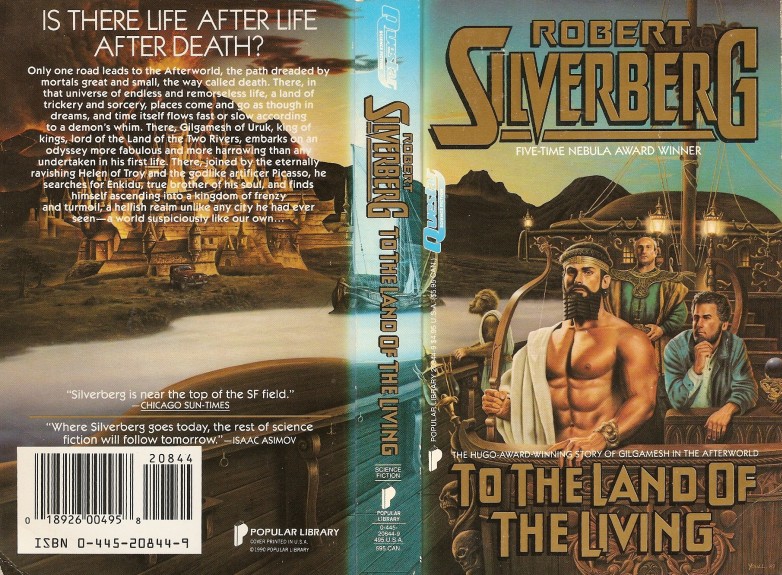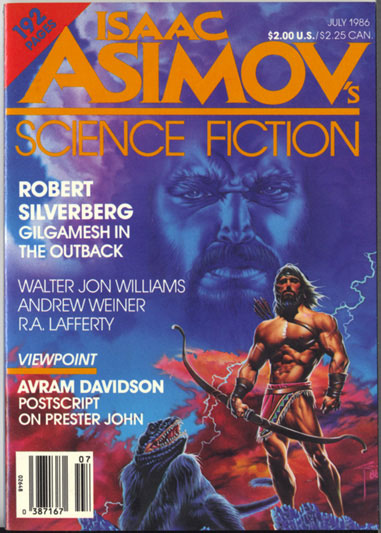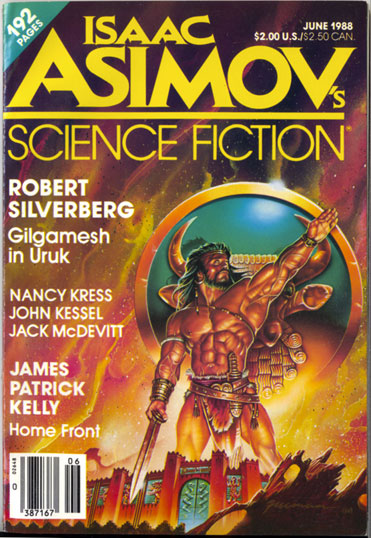 Baen’s “Hell” series edited by Janet Morris ran for seven anthologies and four novels from 1986 to 1989. I remember the series and resisted reading or buying them when they came out. The idea did not appeal to me. The idea is sort of like Philip Jose Farmer’s “Riverworld” series that when a person dies they are in “hell.” A person can die and then come back again. The idea is to have all sorts of people from various times juxtaposed in new adventures.
Baen’s “Hell” series edited by Janet Morris ran for seven anthologies and four novels from 1986 to 1989. I remember the series and resisted reading or buying them when they came out. The idea did not appeal to me. The idea is sort of like Philip Jose Farmer’s “Riverworld” series that when a person dies they are in “hell.” A person can die and then come back again. The idea is to have all sorts of people from various times juxtaposed in new adventures.
Robert Silverberg wrote three novellas featuring Gilgamesh in hell. The stories were first published in Isaac Asimov’s Science Fiction magazine, then in the Baen anthologies, and finally in rewritten and expanded form as a fix-up novel To the Land of the Living.
I read To the Land of the Living for one reason. Silverberg made Robert E. Howard a character in one of the stories.

“Gilgamesh in the Outback” was first in Asimov’s Science Fiction July 1986, and at the same time in Rebels in Hell (Baen Books) in July 1986.
Gilgamesh is restless and leaves the city of Nova Roma and its scheming to go hunting and search for his friend Enkidu. At the same time, Robert E. Howard and H. P. Lovecraft are traveling through the outback in a Land Rover as emissaries for King Henry VIII to Prester John. Robert E. Howard is presented as a burlesque caricature:
“’If you ever come to Texas, H.P., this here’s a lot like what you’d have seen.’
‘Beautiful?’ said the other man uncertainly. ‘Hell?’
“This stretch sure is. But if you think Hell’s beautiful, you should have seen Texas!’”
Silverberg is having some fun of the old saying of given the choice of going to hell or Texas. Lovecraft is almost a cipher. He gives deadpan response to Howard’s statements.
They meet Gilgamesh which is the set-up.
“’By Crom,’ he muttered, staring at the giant. ‘Surely this is Conan of Aquilonia and none other!’ He was trembling. He took a lurching step toward the huge man, holding out both his hands in a strange gesture – submission, was it? ‘Lord Conan?’ And before Lovecraft’s astonished eyes Howard fell to his knees next to the dying beast, and looked up with awe and something like rapture in his eyes at the towering huntsman.”
“The red-faced man seemed to be having a crazy fit. Quivering, shaking, sweating – dropping to his knees – his eyes gleaming insanely –. . .Gilgamesh felt a surge of intense dislike for this fellow. He would be slobbering in another moment.”
“And that glow in the fellow’s eyes – what sort of look was that? A look of adoration, almost the sort of look a woman might give a man when she has decided to yield herself utterly to his will. Gilgamesh had seen such looks aplenty in his day, from women and men both; and he had welcomed them from women, but never from a man. He scowled. What does he think I am?”
Robert Silverberg has Robert E. Howard go full homo.
When I first read this, I thought of culture of critique. Reading further though, Silverberg pokes fun at his own ethnic tribe. Gilgamesh meets Herod Agrippa who is stereotyped:
“There was a soft, sleek, pampered look about him. He dressed well, a Roman-style toga and glossy Italian leather shoes, and some sort of little brocaded skullcap perched jauntily at the back of his head. A shrewd face. Bright beady eyes with undeniable intelligence in them. But something fundamentally unlikable about him. And pushy.”
Herod Agrippa is the prime minister for Sulla in the original version. Silverberg changed Sulla to Simon Magus for To the Land of the Living.
Silverberg has some philosophical ruminations:
“Was it because – as the Christian dead so drearily insisted – because this was Hell, where by definition there could be no delight? To Gilgamesh that was foolishness. Those who came here expecting eternal punishment did indeed get eternal punishment, and it was even more horrendous than anything they had anticipated. It served them right, those true believers, those gullible New Dead, that army of credulous Christians.”
The last novella “Gilgamesh in Uruk” (Asimov’s, June 1988/War in Hell) has Gilgamesh finding a version of the city of Uruk including his mother and Enkidu. The novel takes on he, Enkidu, and Helen of Troy finding a portal to modern day New York City where Robert E. Howard, Lovecraft, and others show up to beckon him back. R.E.H has carnal thoughts again for Gilgamesh.
What saves this all is Silverberg is a pro-writer. Characterization and writing save what would be a mess on other hands.
L. Sprague de Camp’s deeply flawed biography of Robert E. Howard had come out in 1983. My guess is Silverberg read de Camp’s bio of Howard right before he wrote the Gilgamesh stories. De Camp’s ideas were a poison that spread far and wide.
To the Land of the Living is not an essential book. Do pick up Silverberg’s Gilgamesh the King and his old Ace Doubles. He was a master of space opera back in the day.

The “Hell” series was very uneven. I hoped for better.
Silverberg’s later Gilgamesh stories are crap, IMO. That said, those two IASF covers kick ass. Who was/were the artist(s)?